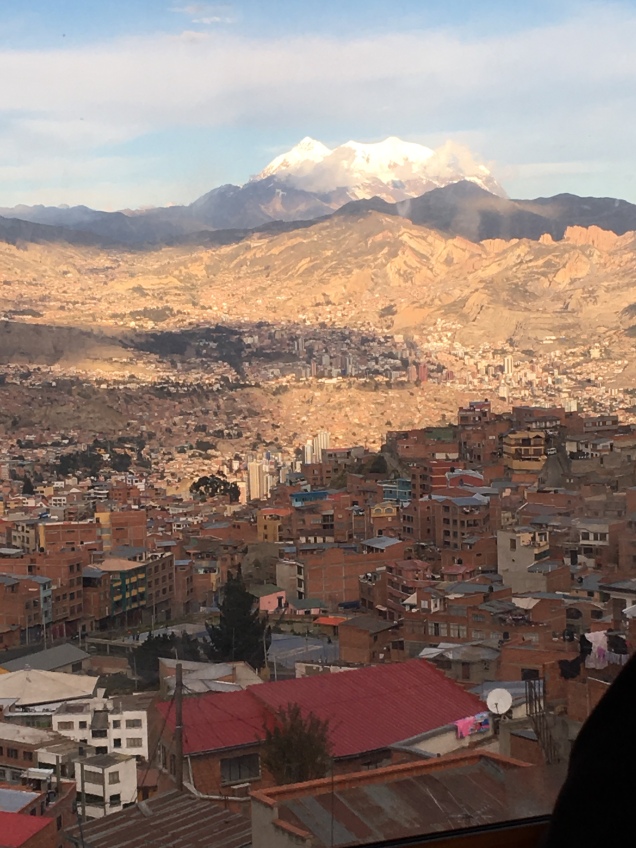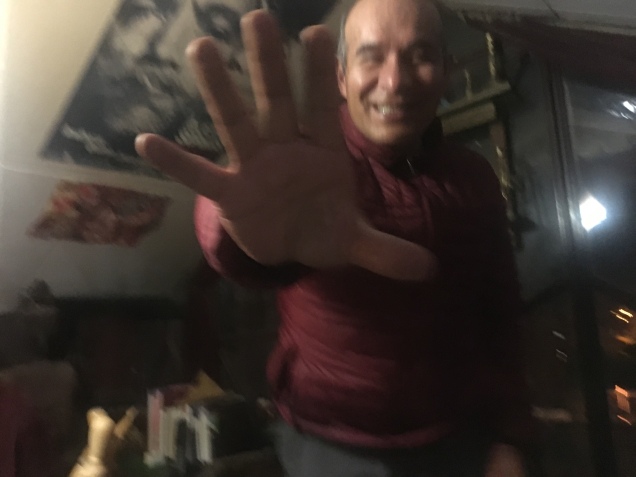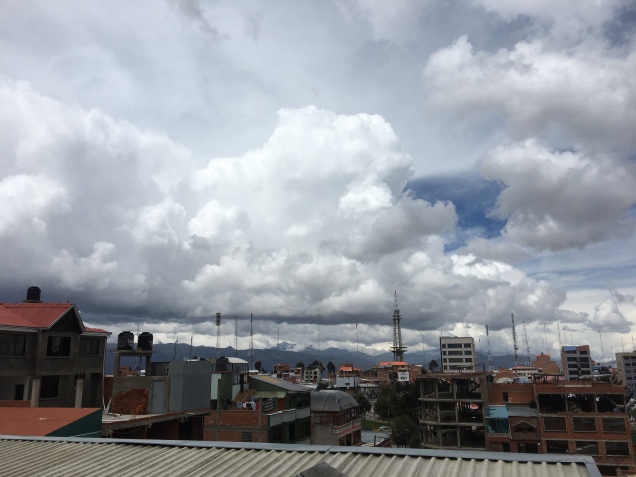De la mano y de pie Hoy la lluvia caía lenta y persistentemente Como un amor constante o como un niño siempre agarrado de las polleras de mamá ojitos escaneando sus alrededores deditos enroscando los pliegues vibrantes cuerpito invisible menos sus piecitos pisando la tierra que nos une Y mi amor estuvo molesto conmigo una vez más No he tenido la sensibilidad cultural para poder desacerme de la mano colonial que me ha criado siempre entrelazado con la mano descolonizador que me ha tratado de enseñar algo Menos blanco Menos abusador Menos arrogante Menos patriótico Menos individualista Más humilde Más tolerante Más abierto Más colectivo Más pacífico Y me pregunto que si al descolonizarnos nos podemos sacudir esa otra mano dura que nos tiene a veces hasta por el cogote cortando la respiración desconcertando nuestros corazones distrayendo nuestros sueños levantando alboroto y confusión para poder siempre controlarnos como patitos tras mamá patita. O nos unimos y nos ponemos de acuerdo O nos arrodillamos y aceptamos nuestro fin.
Hace un par de semanas we rolled into El Alto, fresh from Perú. Y ahí empezamos nuestro aprendizaje de uno de los pueblos más alucinantes, en mi opinión, de Sur América. Nuestro guía por nuestro tiempo en esta ciudad, el Iván del Teatro Trono, nos empezó a contar de su vida y como él llegó a empezar la fundación COMPA o la Fundación Comunidad de Productores en Artes. Su historia, que en otro momento lo escribí, está a continuación pero en inglés. He tratado de traducirlo también al español, espero que se entienda.
The red box/ La caja roja
Iván welcomed us with a smile that made us feel right at home in Trono, a building that also serves as café, gathering place, theater, and home and which was envisioned and designed by Iván himself. The building is a work of art and has many old relics and antiques and scraps from all over La Paz and El Alto that Iván has collected for years. Parts of old buses, historical balconies, and windows from all across the city in various sizes and shapes make up the building façade.
Iván nos dio la bienvenida con una sonrisa que nos hizo sentirnos inmediatamente en casa en Trono, un edificio que también sirve como café, punto de encuentro, teatro y hogar y que fue visionado y diseñado por Iván mismo. El edificio es una obra de arte y tiene muchas reliquias viejas y antigüedades y restos de todo La Paz y El Alto que Iván ha coleccionado durante años. Partes de buses viejos, balcones históricos y ventanas de todo la ciudad en varias formas y tamaños de todo tipo crean la fachada del edificio.
Iván’s personality matches the building in part because he is a gentleman who is not only charming, but at the same time has a depth of personality and purpose that one cannot help but admire and want to get to know.
Su carácter hace juego con la construcción en parte porque el Iván es un caballero quien es encantador pero al mismo tiempo tiene una profundidad de carácter y propósito. Uno no puede hacer más que admirarlo y querer saber más.
He tells us, as we tour Trono, that the house pays homage to the miners that are the populace of El Alto, one of the most socially and politically important centers across the Andes. In 1985, El Alto, perched just above La Paz and the capital’s eyebrow, was officially founded. Home to migrants from all across the country who have mostly come from mining backgrounds, the city’s population has exploded to over one million inhabitants. The mine shafts that are in the basement of Trono help to enact an important story of Bolivian mining and also serves to make sure that Trono stays close to its roots of mining and struggle or lucha. At the same time, the rooftop of the Theater is where the artists wings can take flight. One can enjoy the view of the snow-capped mountains that wrap around La Paz and El Alto in a giant embrace, if the day is clear, and imagine all one’s dreams taking off into literal thin air, at 4000 meters.
Mientras nos da un tour del Trono nos cuenta que la casa sirve como homenaje a los mineros que son quienes han poblado El Alto, uno de los centros más importantes socialmente y políticamente de los Andes. En 1985 El Alto, posado justo arriba de La Paz, la ceja de la capital, fue fundada oficialmente. Hogar para muchos migrantes de todo el país quienes vienen mayormente de contextos mineros. En actualidad la ciudad ha explotado y ahora tiene más que un millón de habitantes. Las galerías que ahora están en el subsuelo del Trono ayudan a dramatizar una historia importante de la minería en Bolivia y también sirven para asegurar que El Trono permanece cerca de sus raíces de minería y de lucha. A su vez, el techo del teatro es donde las alas de los artistas pueden tomar vuelo. Si el día está despejado uno puede disfrutar de la vista de los nevados de las montañas que envuelven a La Paz y El Alto en un abrazo gigante y uno puede imaginar que sus sueños despegan de golpe a los 4.000 mil metros de altura.
In his “charla” or talk with us Iván stars as the protagonist, although he apologizes in advance that he has to tell us his story. On the contrary, I tell Iván, “qué no te de pena, queremos escuchar tu historia,” “don´t worry, we want to hear your story”. And he starts to tell us about his life, born in La Paz. When his dad died in the second guerilla movement that Che Guevara started in Bolivia, Iván too wanted to live his life for something, he wanted to be a revolutionary, a “guerrillero” with a clear purpose.
En su charla Iván protagoniza aunque se disculpa de antemano porque nos tiene que contar su historia. A lo contrario, yo le digo a Iván, “qué no te de pena, queremos escuchar tu historia.” Y nos empieza a contar de su vida. Fue nacido en La Paz. Cuando falleció su padre en la segunda guerrilla del Che, Iván también quiso que su vida tenga propósito, quiso ser un revolucionario, un guerrillero con un propósito bien claro.
Iván’s dad was pursued because of his involvement in the guerrillas. He therefore had many trades so that he could remain out of reach of anyone looking for him. He was a painter, welder, boxer, football player, plumber, etc. For all these trades he needed different instruments or tools so he had a red box full of whatever work element he might ever need. When his father died in `70 he left behind a widow and three kids as well as his red box full of tools of his various trades. Iván’s mom, Elba, started selling the things inside the box, one by one, in order to provide food for her family and little by little everything in the box disappeared.
El papá de Iván fue perseguido por su involucramiento en las guerrillas y la revolución. Por eso es que tuvo muchos oficios para que se pueda permanecer fuera del alcance de cualquier persona que lo esté buscando. Fue un pintor, un soldador, un boxeador, un jugador de fútbol, un plomero, etc. Para todos sus empleos le hacía falta herramientas diferentes así que tenía una caja roja llena de cualquier elemento que le haría falta. Cuando su papá muere en el año 1970 deja atrás a una viuda, tres hijos y una caja roja llena de herramientas para empleos varios. La mamá de Iván, Doña Elba, empieza a vender cosas que encuentra adentro de la caja, una por una, para poder proveer para su familia. De a poquito todo lo que estaba en esa caja desaparece.
Iván then started using the red box as a play toy. He would hide in there and also use it, as his dad did, for storage. Whenever he would come back from the street he would stash different doodads in the box: pieces of wire, leather, glass, little trinkets, whatever he could find lying around outside. His mom would periodically empty out the box. He later realized that it was because there wasn’t much room in their house to have so many things, they lived in a 3 x 4 meter room after all. The years went by and the red box eventually disappeared.
Luego Iván comenzó a usar la caja roja como un juguete. Se escondía ahí y también lo usaba, como lo había usado su papá, para almacenar cosas. Cuando llegaba de la calle siempre guardaba diferentes cachivaches en la caja: alambres, pedacitos de cuero, vidrios, pequeñas chucherías, cualquier cosa que encontraba tirada afuera.
Now, Iván has our group sitting around in a circle in his house. We look around constantly and sometimes distractedly. We are surrounded by every kind of trinket, antique, and thingamajig imaginable. Posters, frames, paintings, and wall hangings cover the ceilings and walls and an eclectic mix of rugs lay obedient under our cross-legged feet. We take it all in for a second and then he says: “That red box is long since gone, but that same red box is now my house, where we find ourselves now. We are all in that red box.”
Ahora Iván nos tiene sentaditos en un círculo en su casa. Miramos constantemente a nuestro alrededor y a veces estamos muy distraídos. Estamos rodeados por cada recuerdo, antigüedad y vaina que se pueda imaginar. Pósters, marcos, cuadros y tapices cubren el techo y las paredes; y una mezcla ecléctica de alfombras descansan obedientes debajo de nuestras piernas cruzadas. Asimilamos todo por un momento y luego nos dice: “Esa caja roja ya no existe más pero esa misma caja roja es ahora mi casa, donde nos encontramos ahora. Estamos todos adentro esa caja roja.”
Aside from the red box that serves as the backdrop for the story of Trono’s mission. Iván started the theater company with 7 young at-risk homeless youth and it has grown since then. Next year Trono will turn thirty years old. Iván tells our group that after finding theater he had no need to be a “guerrillero” because theater is a revolution in and of itself, a tool used to transform people into better versions of themselves.
Aparte de la caja roja que sirve como telón de fondo para la historia de la misión de Trono. Iván empezó la compañía de teatro con siete jóvenes que corrían riesgo y que no tenían casa. Ha crecido desde ese entonces. El año que viene Trono cumplirá treinta años. Iván nos cuenta que después de que encontró el teatro no tuvo ninguna necesidad de ser guerrillero porque el teatro en sí es una revolución–una herramienta que se puede usar para transformar la gente en mejores versiones de ellas mismas.
We can only hope that whoever passes through the door of Trono will become better versions of themselves. Through the workshops we had that got us out of our heads and acting with our bodies and our hearts, we have found another way to interact with the world and ourselves. A beautiful and never-ending work.
Solo podemos esperar que quienquiera pasa por las puertas del Trono se convertirá en una mejor versión de sí misma. Por los talleres que tuvimos que nos hicieron salir de nuestras cabezas y actuando con nuestros cuerpos y corazones hemos encontrando otra forma de interactuar con el mundo y con nosotros mismos. Un trabajo bello e interminable.
***
El Alto se ha construido a base de luchas y resistencia. Se ha fundado por el simple hecho de que las minas del país ya no estaban contratando o no daban el trabajo de antes. Entonces la ciudad se pobló con ex-mineros y ex-campesinos que se mudaron a El Alto para hacerse una vida mejor. Ahora la ciudad tiene más que un millón de habitantes con tan solo 33 años de ser fundada.
Mientras en Trono vimos un video en que la tropa tronera actuaba su interpretación de la Guerra del Gas, una gran tragedia para el pueblo boliviano pero una lección en la fuerza que tiene el pueblo. Ocurrió en el 2003 cuando el gobierno de Bolivia y un tal presidente Sánchez de Lozada (muy agringado ya) decide exportar gas por Chile a los Estados Unidos a un precio re bajo. Hubo un conflicto armado con los militares y la población de El Alto y mueren más de 60 personas en cuatro días.
Este hecho es solo una representación de como es El Alto en cuanto a su rebeldía. Iván nos enumera cinco fuerzas que definen en gran parte la memoria de la rebeldía boliviana. La rebeldía nace por movimientos liderados por indígenas, mineros, mujeres, jóvenes, y por último la creatividad. Nos cuenta que El Alto tiene una población bastante joven. De hecho, más de dos tercios del pueblo tiene menos que treinta años. Imagínense una sociedad liderado por jóvenes creativos–las posibilidades son innumerables, creo yo.
Entonces…les quería contar algunos de estos hechos e historias para poder decirles que el eslogan de Teatro Trono y de El Alto en muchos casos es “El Alto de pie, nunca de rodillas.” Esto se debe a que están siempre listos para luchar y para resistir. Para cobrar lo que les corresponde y contar las historias para seguir una vida más noble, más creativa, más crítica.
He aprendido mucho de este pueblo y también de ser una persona blanca y del norte que se mueve en estos espacios–siempre con privilegio. Trato de enseñar a mis estudiantes que estamos en este lugar para aprender. Les reto que observen, escuchen, pregunten, y de ahí podemos hablar de soluciones. Pero somos nosotros que nos toca arrodillarnos a los pecados que nuestros antepasados y nosotros mismos hemos realizado y aprender de nuestros errores. Quizás algún día podamos también ponernos de pie y tomarnos de la mano–el Norte y el Sur en un círculo que nos pueda unir.
*A continuación fotos de paisajes de El Trono y una fotito de Iván.







